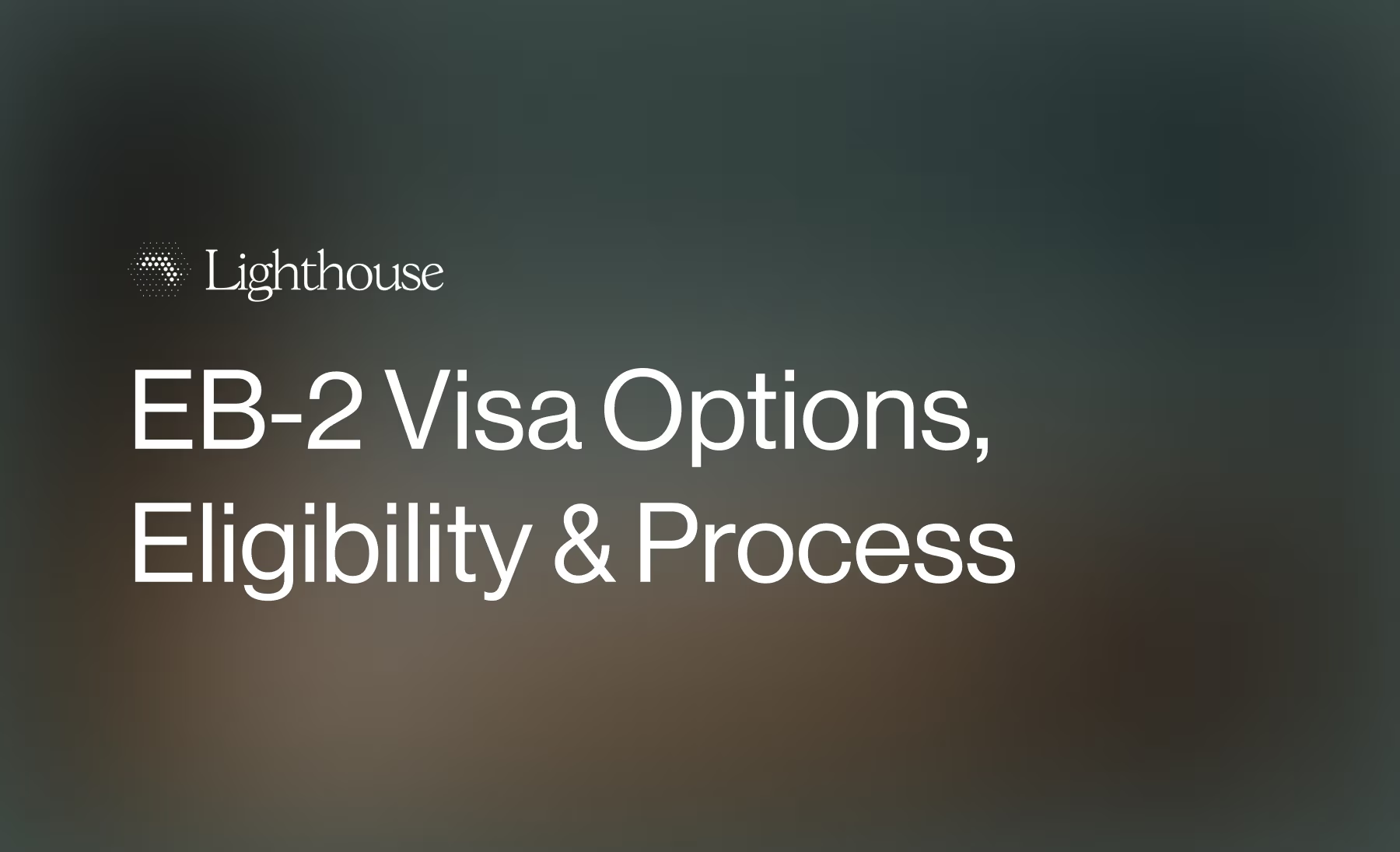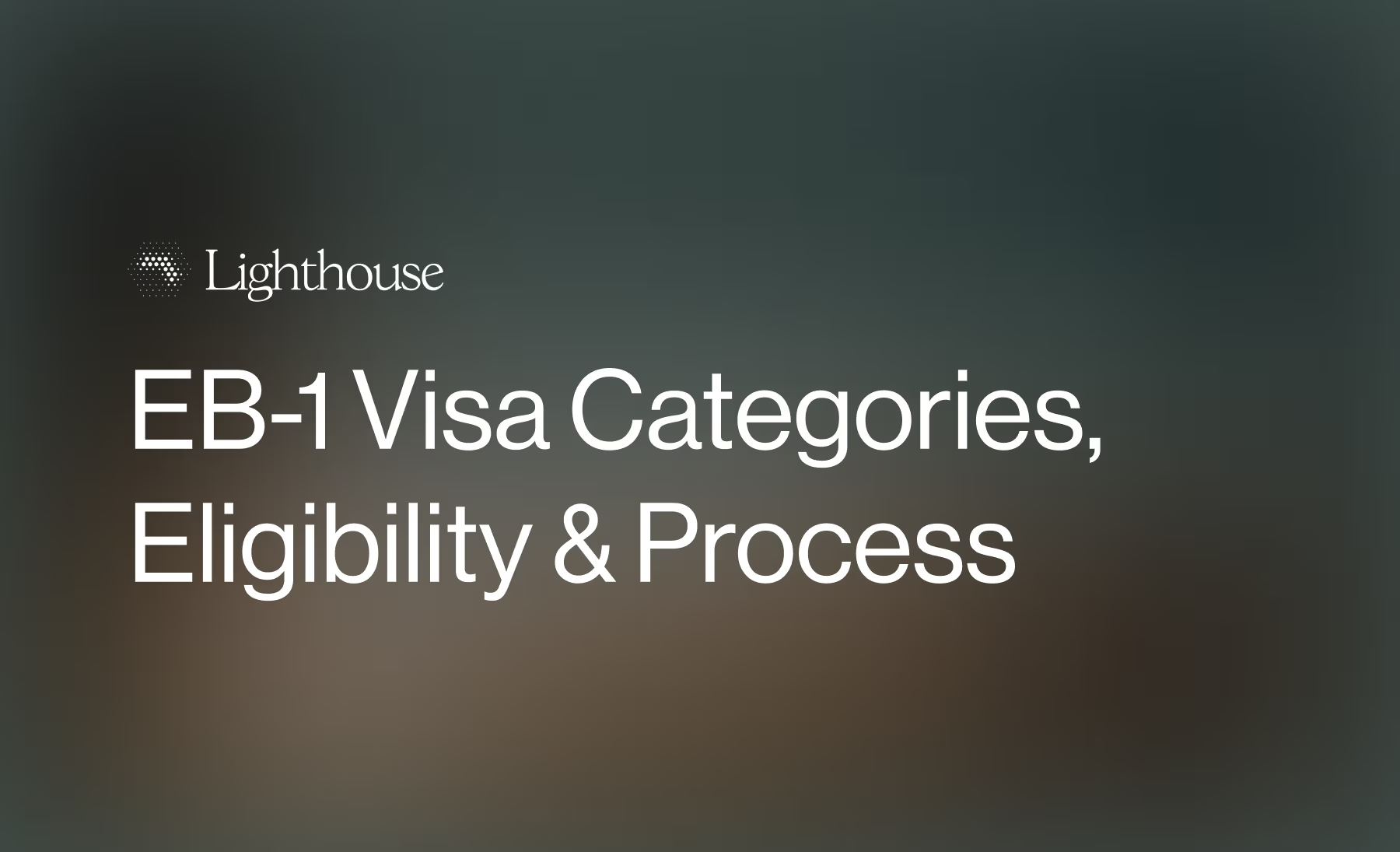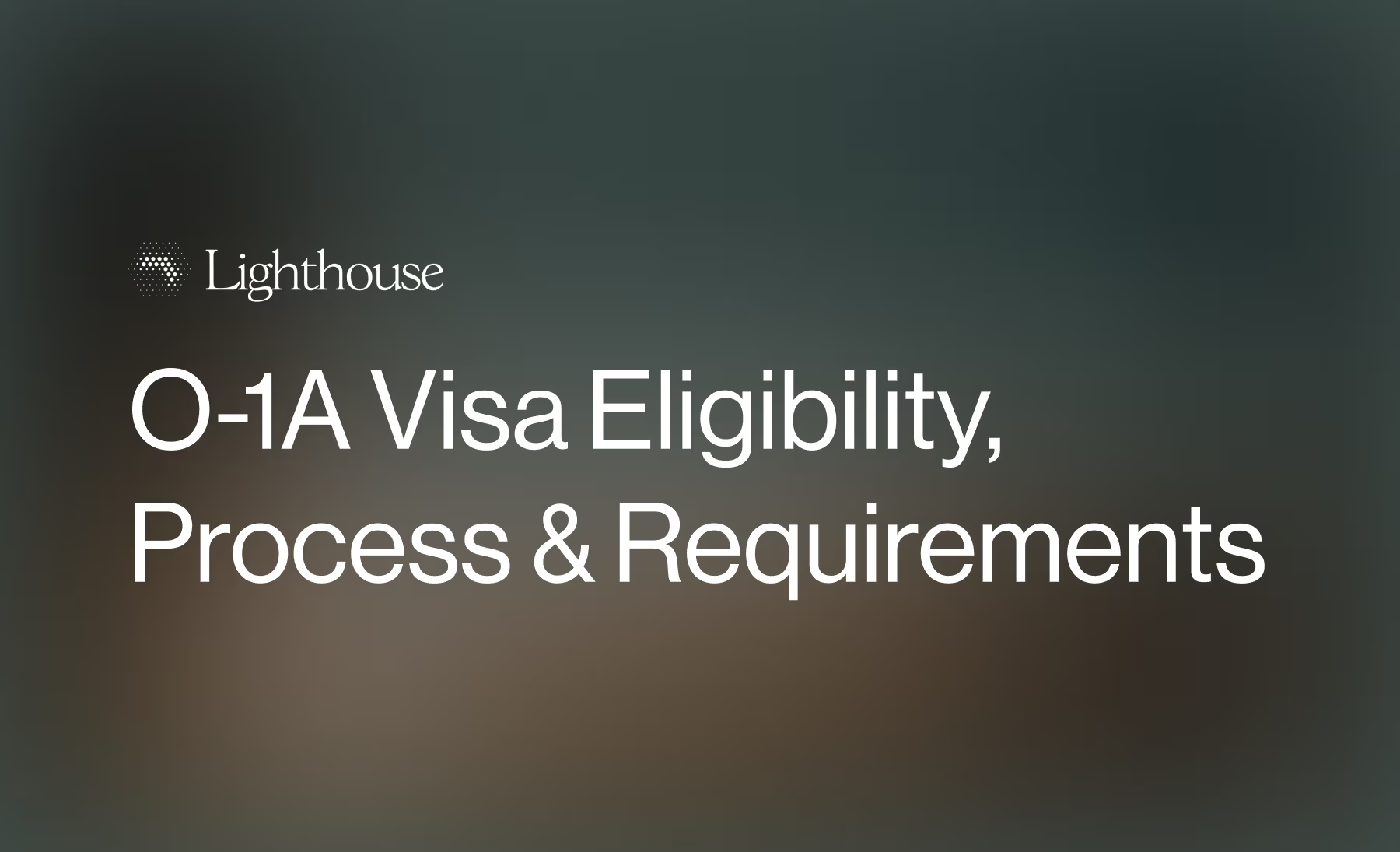Form I-907 Explained
Everything you need to know about Form I-907 for premium processing requests.


If you're facing long USCIS processing times that could derail a job start date or critical business timeline, Form I‑907 offers a solution. This guide explains how to use the request for premium processing service to expedite your immigration petition and what it costs to cut months of waiting down to weeks—and gain certainty in the process.
Without premium processing, there’s no guaranteed timeframe for when USCIS will act on your case; with it, you know exactly when to expect a decision.
What is Form I-907?
Form I-907 is the official form used to request premium processing service for eligible immigration petitions and applications. When you file Form I-907 alongside your underlying petition, USCIS guarantees they'll take action within a specific timeframe rather than standard processing times that can stretch for months.
The form serves as your request for premium processing service, a paid expedite option that prioritizes your case. Premium processing speeds adjudication and carries a fee refund guarantee if USCIS fails to act within the promised timeframe.
Premium processing operates under regulations established by the U.S. Department of Homeland Security and administered by U.S. Citizenship and Immigration Services. The current edition date for Form I-907 is 04/01/24. Using an outdated version will result in rejection.
Eligibility for Form I-907: Which petitions qualify
Not every immigration benefit request qualifies for premium processing. USCIS limits the service to specific petition types, primarily employment-based cases where speed provides clear value to employers and nonimmigrant workers.
Form I-129 (Petition for a Nonimmigrant Worker) covers most temporary work visas including H-1B, L-1, O-1, P-1 and TN classifications. This represents the largest category of premium processing requests since employers often need definitive answers for hiring decisions and visa start dates.
Form I-140 (Immigrant Petition for Alien Worker) applies to employment-based permanent residence categories like EB-1, EB-2 and EB-3. Premium processing helps resolve green card petitions faster, which can unlock extensions and dependent work authorization.
Form I-539 (Application to Extend/Change Nonimmigrant Status) covers certain student categories including F-1, M-1 and J-1 classifications, plus some dependent classifications.
Form I-765 (Application for Employment Authorization) applies to specific categories including F-1 students pursuing STEM OPT, spouses of certain visa holders and other eligible populations.
Only the petitioner, applicant or their attorney or accredited representative can file Form I-907. If an attorney or accredited representative files on behalf of someone else, they must include Form G-28 (Notice of Entry of Appearance as Attorney or Accredited Representative).
The beneficiary of a petition typically cannot file Form I-907 unless they are also the petitioner or applicant for the underlying case. For example, an H-1B beneficiary cannot file premium processing for their employer's Form I-129 petition.
You can’t request premium processing after USCIS has made a final decision on your related case. The underlying petition must still be pending for Form I-907 to be accepted.
Where to file Form I-907
Filing location depends on your underlying petition type and whether you're submitting online or by mail. USCIS maintains specific mailing addresses for different service centers and petition categories.
For paper filing, send your completed Form I-907 to the same USCIS service center processing your underlying petition. Each service center handles different geographic regions and petition types, so using the wrong mailing address delays your request.
The USCIS website provides current addresses on their Direct Filing Addresses for Form I-907 page. These addresses change periodically, so verify before mailing.
Some categories now offer online filing through your USCIS online account. This includes certain Form I-539 change of status requests for F-1, M-1 and J-1 classifications, plus related Form I-765 applications. Online filing provides immediate confirmation and eliminates mail delays.
When filing online, you'll upload your completed Form I-907 and pay the premium processing fee electronically. The system will prompt you for your related case receipt number and verify eligibility before accepting payment.
Always use the current edition date regardless of filing method. USCIS will reject outdated forms, forcing you to refile and potentially miss critical timing.
Form I-907 filing fees and payment methods
The premium processing fee varies by petition type and is paid in addition to your underlying petition filing fees. Current rates as of October 2025:
- Form I-129: Varies based on which petition you are filing
- Form I-140: $2,805 for most categories
- Form I-539: $1,965 for eligible applications
- Form I-765: $1,685 for qualifying categories
These filing fees can vary significantly from year to year. Submitting incorrect fees results in automatic rejection, so verify current amounts on the USCIS fee schedule before filing.
Payment methods for paper filing:
- Personal check or money order payable to "U.S. Department of Homeland Security"
- Cashier's check from a U.S. bank
- Form G-1450 for credit card payments (where accepted)
Online filing payment:
- Credit or debit card through the secure USCIS website portal
- Bank transfer for certain account types
Submit a separate payment for your premium processing fee. Never combine it with your underlying petition payment. This creates processing confusion and can delay both forms.
Keep detailed payment records, including check numbers, money order receipts or credit card confirmations. These serve as proof of payment if questions arise.
How to file Form I-907: Step-by-step process
Step 1: Verify eligibility and gather information
Confirm your underlying petition qualifies for premium processing by checking the current USCIS website guidance. Categories occasionally get suspended or modified.
Collect your receipt number from your pending petition. This links your premium processing request to the correct case. If filing concurrently with your underlying petition, you won't have a receipt number yet. Leave that section blank.
Step 2: Complete Form I-907 accurately
Download the current edition from uscis.gov. Using black ink for paper forms helps guarantee clear scanning and processing.
Key information required:
- Your full name exactly as it appears on the underlying petition
- A-number (alien registration number), if you have one
- Related case form number (I-129, I-140, etc.)
- Receipt number if available
- Classification or category being requested
- Contact information, including mailing address and phone number
Complete item numbers carefully. Each section corresponds to specific information about your request and the related case. Incomplete or incorrect entries trigger delays or rejections.
If you're an attorney or accredited representative filing for a client, complete the preparer section and attach Form G-28. This authorizes you to act on the client's behalf and receive official communications.
Step 3: Calculate and prepare the payment
Determine the exact premium processing fee for your petition type. Double-check current rates since they change periodically.
Prepare a separate payment for the premium processing fee only. Never combine this with your underlying petition payment.
For paper filing, write your full name and A-number (if available) on checks or money orders. This helps USCIS match the payment to the correct case if papers get separated.
Step 4: Submit your request
Concurrent filing: Submit Form I-907 together with your underlying petition to the appropriate service center. Include both forms in the same package with separate payments.
Upgrade filing: Submit Form I-907 after your underlying petition is already pending. Send it to the service center currently processing your case, using the receipt number to link the requests.
For paper filing, use certified mail or a trackable delivery service. This service confirms that your request was received and helps resolve delivery issues.
For online filing, complete the process through your USCIS online account.
Step 5: Track your request and respond to USCIS actions
After submission, you’ll receive a receipt notice for your Form I-907. This confirms they've accepted your request and started the premium processing clock.
Monitor your case status through your online account or by calling the customer service line with your receipt number.
If USCIS issues a request for evidence or notice of intent to deny, the premium processing timeframe pauses until you submit your response. Once they receive your response, the clock resumes for the remaining days in the original timeframe.
Step 6: Receive USCIS decision
Within the guaranteed timeframe, USCIS will take action on your case by approving, denying or requesting additional information.
If they approve your petition, you'll receive an approval notice and can proceed with the next steps, like consular processing or status changes.
If they deny your petition, you'll receive a detailed denial notice explaining their reasoning. Premium processing doesn't guarantee approval, only faster adjudication.
If USCIS fails to act within the promised timeframe, they'll refund your premium processing fee and continue processing your case at regular priority.
Form-filling tips to avoid common mistakes
Edition date compliance: Always use Form I-907 with edition date 04/01/24. USCIS automatically rejects older versions, requiring you to refile with the correct forms. Verify that all pages come from the same edition.
Payment precision: Submit exact filing fees based on current fee schedules. Round numbers or estimated amounts result in rejection. Keep fee payments completely separate from your underlying petition payments.
Attorney representation: If using an attorney or accredited representative, they must file Form G-28 unless they previously filed one for your case that remains valid. Missing or expired Form G-28 forms prevent attorneys from receiving communications about your case.
Complete item numbers: Every section of Form I-907 requires specific information. Blank fields often trigger requests for additional information or delays. If a field doesn't apply to your situation, write "N/A" rather than leaving it empty.
Consistent naming: Use your full name exactly as it appears on your underlying petition and other government documents. Name variations can create processing delays while USCIS confirms they're handling the correct person.
Clear mailing address: Provide complete, accurate contact information. USCIS sends important notices to the address on your Form I-907 and delivery failures can affect your case timeline.
Documentation copies: Keep copies of your completed Form I-907, payment records and mailing confirmations. These serve as your record if questions arise about your filing.
The premium processing service timeline
Form I-907 dramatically reduces USCIS decision timeframes compared to regular processing. Standard petitions often take many months; premium processing guarantees action within calendar days.
Current premium processing timeframes:
- 15 calendar days for most Form I-129 and Form I-140 petitions
- 30 calendar days for eligible Form I-539 and Form I-765 applications
The timeframe begins when your properly filed Form I-907 is accepted, not when you mail it. Online filing provides immediate confirmation, while paper filing depends on delivery and initial processing time.
"Taking action" means USCIS will approve your petition, deny it, issue a request for evidence or issue a notice of intent to deny within the specified timeframe. This doesn't necessarily mean final approval since additional steps like consular processing may still be required.
When the clock pauses: If USCIS requests additional evidence or issues a notice of intent to deny, the premium processing timeline stops until you respond. After they receive your response, the remaining days in the original timeframe resume.
Refund guarantee: If USCIS fails to take action within the promised timeframe, they'll refund your premium processing fee. Your case continues at regular processing priority, but you get your money back for the service failure.
Standard processing times vary significantly by petition type, service center and current workloads. Premium processing removes this uncertainty by providing definitive timelines regardless of other factors.
Benefits of using Form I-907
Premium processing gives both employers and nonimmigrant workers a predictable timeline instead of months of uncertainty. With a guaranteed response window, you know exactly when USCIS will act on your case.
But premium processing isn’t available for every petition type. Family‑based immigration, naturalization and many humanitarian categories are excluded regardless of urgency. And while valuable, the service does have limitations.
Streamline your immigration process with Lighthouse
Speed matters, but accuracy determines outcomes. Lighthouse supports employers, founders, and professionals through every stage of the immigration process, from preparing the underlying petition to managing Form I‑907 filings when premium processing makes strategic sense.
Beyond premium processing, Lighthouse provides a full immigration support system: document preparation aligned with USCIS standards, case tracking through your USCIS online account, and proactive communication to keep filings on schedule. Whether you’re filing Form I‑129, Form I‑140, Form I‑539, or Form I‑765, Lighthouse helps you move faster with confidence and compliance.
Get in touch with Lighthouse today for a consultation about incorporating premium processing into your visa strategy.
FAQs about Form I-907
What is Form I‑907?
It’s the USCIS form used to request premium processing for certain petitions and applications. When filed correctly, it guarantees that U.S. Citizenship and Immigration Services will take action within a fixed number of calendar days. Lighthouse can help you determine whether your case qualifies and help prepare your Form I‑907 alongside your underlying petition to avoid delays.
Who can file Form I‑907?
The petitioner, applicant, or their accredited representative may file. The beneficiary cannot file unless they are also the petitioner. Lighthouse coordinates with both employers and attorneys to make sure the right party signs and submits the form, supported by a valid Form G‑28 when required.
Where to file I‑907?
You can file online through your USCIS online account (if eligible) or mail the form to the correct service center listed on the USCIS website. Lighthouse verifies the correct mailing address, edition date, and service center before submission to prevent rejections.
How much is the I‑907 filing fee?
The I‑907 filing fee ranges from $1,685 to $2,805, depending on the underlying form type. Payment must be separate from other filing fees and made by check, money order, or credit card (via Form G‑1450). Lighthouse can help you confirm the correct amount and payment method for your case to avoid returned filings.
What is the I‑907 processing time?
Premium processing guarantees action within 15 or 30 calendar days, depending on the petition type. Lighthouse tracks your receipt number through the USCIS online account and alerts you to any USCIS issues or requests for evidence that pause the clock.
What happens if USCIS issues a Request for Evidence?
The premium clock stops until your response is received. Lighthouse can help prepare the supporting documentation and organize your additional information so the case resumes smoothly once submitted.
Can I withdraw a premium processing request?
Yes, but the premium processing fee is refundable only if USCIS fails to act within the guaranteed timeframe. Lighthouse can assist with withdrawal requests and confirm whether a refund applies.
Does filing Form I‑907 guarantee approval?
No. Premium processing only guarantees faster adjudication, not a specific outcome. Lighthouse focuses on strengthening the underlying petition so that when USCIS reviews your case, it’s complete, compliant, and ready for approval.
Lighthouse provides expert guidance and legal review to strengthen your case.
From document prep to USCIS submission, Lighthouse ensures your petition meets every requirement.

%201.svg)




